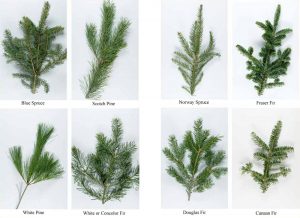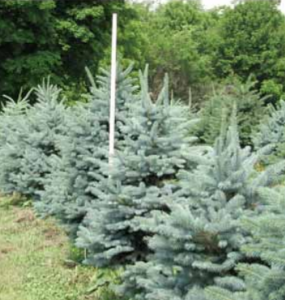 Purdue University - Extension - Forestry and Natural Resources
Purdue University - Extension - Forestry and Natural Resources
Got Nature? Blog
 So you are off to select a real Christmas tree this year? The tree characteristics that influence a family’s decision on what species to select can vary greatly. First, many families just want the experience of cutting their own tree. In this case, any appropriately priced and correct sized tree will do. Other consumers may be more demanding in terms of different tree characteristics. These include fragrance of the tree, rather the tree is cone or more globose shaped, needle length, and of course expected needle retention. Color is also to be considered, as well as branch stiffness and cost. These factors all come into play rather the purchaser is aware of them or not. They all interact in one way or another to define the perfect Christmas tree and to create great Christmas memories.
So you are off to select a real Christmas tree this year? The tree characteristics that influence a family’s decision on what species to select can vary greatly. First, many families just want the experience of cutting their own tree. In this case, any appropriately priced and correct sized tree will do. Other consumers may be more demanding in terms of different tree characteristics. These include fragrance of the tree, rather the tree is cone or more globose shaped, needle length, and of course expected needle retention. Color is also to be considered, as well as branch stiffness and cost. These factors all come into play rather the purchaser is aware of them or not. They all interact in one way or another to define the perfect Christmas tree and to create great Christmas memories.
There are about 200 real Christmas Tree Farms producing trees on over 2,500 acres in Indiana. Each year about 90,000 Christmas trees are harvested in Indiana and over a billion dollars in sales are made throughout the U.S. Based on number of trees harvested, Indiana ranks seventh among all states. Most of the farms are choose and cut operations but some wholesale farms, particularly in Northern Indiana, also exist. Real Christmas trees are also sold at retail outlets.
Scotch pine, consisting of several varieties, remains the most commonly grown Christmas tree in Indiana. However, as transportation and communications improved the desire for other species such as the firs and spruces increased. Because climate and soil conditions vary substantially from one end of Indiana to the other, not all species will be found in one area and probably not all on one farm. However, most Indiana farms will have three or four species available.
Scotch pine and white pine are usually the least expensive trees whereas the true fir, are more costly. Douglas fir (not a true fir) and spruce are usually intermediate in cost. The pines will grow on most soils in Indiana and do not require fertilization. Fraser-fir and Canaan fir will only grow on well to moderately well drained soils, require fertilization, and are in relatively short supply as choose and cut trees, especially in southern Indiana. Some farms do not have true firs available in the field. Douglas-fir and spruce trees are intermediate in the care they require while in the field and thus usually intermediate in price. However, growers may have a surplus of a certain species or size of trees and reduce the price to assure that the trees will be sold.
To view the table that presents the common characteristics which help to determine a consumer’s preference for a certain species, as well as read the full article, view the Selecting an Indiana-Grown Christmas Tree publication. However, in the end, it comes down to a family’s preference. The preferred species can also be determined by memories of past Christmases.
In addition to the most commonly produced Indiana species described in the publication, other species may be available. Noble fir and grand fir are shipped in from the west coast and balsam fir from the Lake States and Canada. Balsam fir has been a fairly popular species in the past. Some growers are experimenting with other species such as Korean fir, Turkish fir, and Nordman fir. These are beautiful trees but since it can take at least seven years for these trees to reach Christmas tree size, don’t expect to find many choose and cut trees available just yet.
For more information about Christmas trees or to locate a choose-and-cut tree farm near you, please visit the Indiana Christmas Tree Growers’ website, or the National Christmas Tree Association website.
Resources:
A Choose-and-Cut Pine and Fir Christmas Tree Case Study, The Education Store, Purdue Agriculture’s resource center
Living Christmas Trees For The Holidays and Beyond, The Education Store
Tips for First-Time Buyers of Real Christmas Trees, The Education Store
Growing Christmas Trees, The Education Store
Daniel Cassens, Professor Emeritus
Purdue Department of Forestry and Natural Resources

Recent Posts
- Purdue Extension 2024 Impact Report
Posted: January 16, 2025 in Forestry, Land Use, Plants, Publication, Wildlife, Woodlands - Opt in to the Deer Management Survey – Wild Bulletin
Posted: January 15, 2025 in Forestry, Urban Forestry, Wildlife - January is a Good Month for Wildlife Tracks – Wild Bulletin
Posted: January 14, 2025 in Urban Forestry, Wildlife - Announcing-New Indiana Woodland Steward Newsletter
Posted: December 19, 2024 in Forestry, Timber Marketing, Wildlife, Woodlands - Red in Winter – What Are Those Red Fruits I See?
Posted: December 18, 2024 in Forestry, Plants, Urban Forestry, Wildlife, Woodlands - ID That Tree: Prickly Ash
Posted: December 16, 2024 in Forestry, Forests and Street Trees, Urban Forestry, Wildlife - Tips on How You Can Recycle Your Christmas Tree
Posted: in Ask the Expert, Christmas Trees, Forestry, Forests and Street Trees, How To, Wildlife - Hardwood Tree Improvement Regeneration Center (HTIRC) Shares Fall Newsletter, Research and Outreach
Posted: December 13, 2024 in Forestry, Land Use, Natural Resource Planning, Woodlands - Ask An Expert: Holidays in the Wild
Posted: December 9, 2024 in Christmas Trees, Forestry, Forests and Street Trees, How To, Plants, Wildlife, Woodlands - Venison Workshops Help Hunters to Safely Process Deer – ANR
Posted: December 4, 2024 in Forestry, Wildlife, Woodlands
Archives
Categories
- Alert
- Aquaculture/Fish
- Aquatic/Aquaculture Resources
- Ask the Expert
- Christmas Trees
- Community Development
- Disease
- Drought
- Forestry
- Forests and Street Trees
- Gardening
- Got Nature for Kids
- Great Lakes
- How To
- Invasive Animal Species
- Invasive Insects
- Invasive Plant Species
- Land Use
- Natural Resource Planning
- Nature of Teaching
- Plants
- Podcasts
- Ponds
- Publication
- Safety
- Spiders
- Timber Marketing
- Uncategorized
- Urban Forestry
- Webinar
- Wildlife
- Wood Products/Manufacturing
- Woodland Management Moment
- Woodlands
